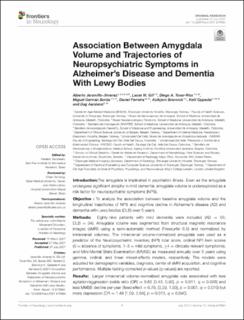| dc.contributor.author | Jaramillo-Jiménez, Alberto | |
| dc.contributor.author | Melvær, Giil Lasse | |
| dc.contributor.author | Tovar-Rios, Diego Alejandro | |
| dc.contributor.author | Borda, Miguel Germán | |
| dc.contributor.author | Ferreira, Daniel | |
| dc.contributor.author | Brønnick, Kolbjørn Kallesten | |
| dc.contributor.author | Oppedal, Ketil | |
| dc.contributor.author | Aarsland, Dag | |
| dc.date.accessioned | 2021-08-17T11:51:40Z | |
| dc.date.available | 2021-08-17T11:51:40Z | |
| dc.date.created | 2021-07-07T09:56:15Z | |
| dc.date.issued | 2021 | |
| dc.identifier.issn | 1664-2295 | |
| dc.identifier.uri | https://hdl.handle.net/11250/2768852 | |
| dc.description.abstract | Introduction: The amygdala is implicated in psychiatric illness. Even as the amygdala undergoes significant atrophy in mild dementia, amygdala volume is underexplored as a risk factor for neuropsychiatric symptoms (NPS).
Objective: To analyze the association between baseline amygdala volume and the longitudinal trajectories of NPS and cognitive decline in Alzheimer's disease (AD) and dementia with Lewy bodies (DLB) over 5 years.
Methods: Eighty-nine patients with mild dementia were included (AD = 55; DLB = 34). Amygdala volume was segmented from structural magnetic resonance images (sMRI) using a semi-automatic method (Freesurfer 6.0) and normalized by intracranial volumes. The intracranial volume-normalized amygdala was used as a predictor of the Neuropsychiatric Inventory (NPI) total score, ordinal NPI item scores (0 = absence of symptoms, 1–3 = mild symptoms, ≥4 = clinically relevant symptoms), and Mini-Mental State Examination (MMSE) as measured annually over 5 years using gamma, ordinal, and linear mixed-effects models, respectively. The models were adjusted for demographic variables, diagnosis, center of sMRI acquisition, and cognitive performance. Multiple testing-corrected p-values (q-values) are reported.
Results: Larger intracranial volume-normalized amygdala was associated with less agitation/aggression (odds ratio (OR) = 0.62 [0.43, 0.90], p = 0.011, q = 0.038) and less MMSE decline per year (fixed effect = 0.70, [0.29, 1.03], p = 0.001, q = 0.010) but more depression (OR = 1.49 [1.09, 2.04], p = 0.013, q = 0.040).
Conclusions: Greater amygdala volume in mild dementia is associated with lower odds of developing agitation/aggression, but higher odds of developing depression symptoms during the 5-year study period. | en_US |
| dc.language.iso | eng | en_US |
| dc.publisher | Frontiers | en_US |
| dc.rights | Navngivelse 4.0 Internasjonal | * |
| dc.rights.uri | http://creativecommons.org/licenses/by/4.0/deed.no | * |
| dc.title | Association Between Amygdala Volume and Trajectories of Neuropsychiatric Symptoms in Alzheimer’s Disease and Dementia With Lewy Bodies | en_US |
| dc.type | Journal article | en_US |
| dc.type | Peer reviewed | en_US |
| dc.description.version | publishedVersion | en_US |
| dc.rights.holder | Copyright 2021 The Authors | en_US |
| dc.source.articlenumber | 679984 | en_US |
| cristin.ispublished | true | |
| cristin.fulltext | original | |
| cristin.qualitycode | 1 | |
| dc.identifier.doi | 10.3389/fneur.2021.679984 | |
| dc.identifier.cristin | 1920613 | |
| dc.source.journal | Frontiers in Neurology | en_US |
| dc.identifier.citation | Frontiers in Neurology. 2021, 12, 679984. | en_US |
| dc.source.volume | 12 | en_US |

